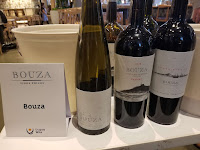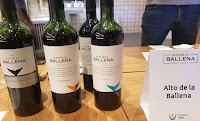Some say that the designation "Verde"(green) is due to the acidity and freshness characteristic of Vinho Verde and that it reminds one of unripe fruit. Others say that the origin "Verde"(green) is explained by the fact that the wine is produced in a region very rich in vegetation and is therefore very green even in winter. -- Wines of Portugal
Originally defined on September 18, 1908, the demarcated Vinho Verde Region extends across the northwest of Portugal, in the area traditionally known as Entre-Douro-e-Minho. The Minho River is its northern border, forming part of the border with Spain, its southern border is formed by the Douro River and the Freita, Arada and Montemuro mountains, to the east it's bordered by the mountains of Peneda, Gerês, Cabreira and Marão, and the western border is the Atlantic Ocean. In terms of geographical area, it is the largest Portuguese demarcated region, and one of the largest in Europe. -- Vinho Verde Wines
According to Wines of Portugal, "the denomination is divided into nine distinct sub-regions, Monção e Melgaço, Lima, Basto, Cávado, Ave, Amarante, Baião, Sousa and Paiva. Monção e Melgaço are the most singular of the sub-regions, the only one protected from the direct Atlantic influence, with a maritime and continental climate, producing fuller-bodied wines with higher alcohol content...The vineyards are concentrated along the valleys of the main rivers. The soils are homogeneous and mostly granite, fertile to very fertile, with high acidity.
Vinho Verde is characterized by unusual vineyard management techniques, from the unique "enforcado vine" layout, with vines intertwined in the trees, to the pergola system, also known as "latada", passing through the "cruzeta", to the nowadays more usual simple cordon system." This system alleviates the higher chances of fungal diseases caused by high rainfall and humid summers due to the region's proximity to the Atlantic Ocean".
The vineyards are concentrated along the valleys of the main rivers. The fertile soils are mostly granite with high acidity. Inland from the coastal areas, the majority of vineyards are planted along the numerous river valleys and the major waterways of the Minho and Douro rivers (and their tributaries).The wines we sampled where a combination of coastal and inland and represented the major grape varieties of Alvarinho, Arinto, Avessa, and Laureiro, as well Espadeiro and the sole red grape, Vinhao (also known as Souzão in the Douro Valley). This last grape variety was presented through the Casa de Vila Pouca, Vinhao Reserva 2021. Surprisingly, this was perhaps the most acidic wine of the group. The grapes come from an inland estate at a high altitude and planted in granite soils. Expect dark colors and racy black currents.
Avesso wines are typically quite low in acid and high in potential alcohol - quite the opposite of the other Vinho Verde grapes. It is this particular quality that earned the variety its name; "avesso" being Portuguese for "reverse" or "opposite". That being said, the Manuel Costa & Filhos Magnate Colheita Selecionada Avesso 2022 shows clear acidity along with pear, white peaches and melon notes. The older Quinta da Lixa Colinas do Avesso 2018 shows a little petrol and nuttiness with less acidity and more funk.
There were many other wines we tasted during the masterclass and reception afterwards. I look forward to continue this exploration into Vinhos Verdes -- particularly through a pilgrimage along the Portuguese Camino.
















































